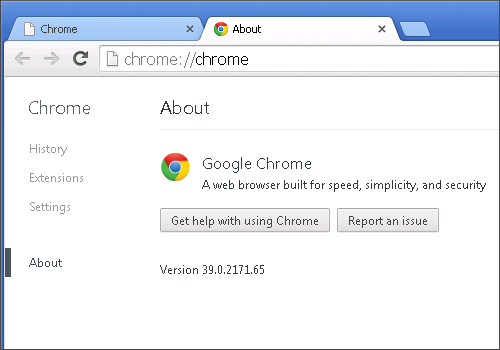Posted by on November 18, 2014
Today Google Chrome team released the stable version of Chrome 39 on Windows, Mac and Linux. We're quick at Browserling and we're happy to announce that we've added Chrome 39 browser to Browserling a few minutes after it was released. It's now available to all our paying and free customers.

Try Chrome 39 in Browserling now!
Significant changes in Chrome 39:
- Removes SSL/TLS protocol version fallback to SSLv3.
- 64-bit support for Mac.
- A number of new apps/extension APIs.
Significant changes in Android version of Chrome 39:
- Number of bug fixes and performance improvements.
- Experimental Reader Mode can be enabled via
chrome://flags, is not available for tablets in this version.
Chrome 39 adds the following new features:
- Beacon - This specification defines an interoperable means for site developers to asynchronously transfer small HTTP data from the User Agent to a web server. Initiated by the navigator.sendBeacon() method, the 'beacon' data will be transmitted by the User Agent as soon as possible, but independent of document navigation. The sendBeacon method returns true if the user agent is able to successfully queue the data for transfer. Otherwise it returns false.
- Generators (ES6/JavaScript 6) - A generator is a special type of function that works as a factory for iterators.
- Web Animations Javascript API (playback control) - A unified model for supporting animation and synchronization on the Web platform. This feature covers playback control of AnimationPlayer: play(), pause(), reverse(), finish(), currentTime, startTime, playbackRate and playState.
- Web Application Manifest - This specification defines a JSON-based manifest, which provides developers with a centralized place to put metadata associated with a web application. This includes, but is not limited to, the web application's name, links to icons, as well as the preferred URL to open when the user launches the web application. The manifest also allows developers to declare a default orientation for their web application, as well as how the application is to be displayed by the user agent (e.g. in fullscreen).
- meta-theme-color - The meta-theme-color is the color of the brand, browser may use it when a distinct color representation is needed.
The new release also includes 42 security fixes. Most notably:
- CVE-2014-7899: Address bar spoofing. Credit to Eli Grey.
- CVE-2014-7900: Use-after-free in pdfium. Credit to Atte Kettunen from OUSPG.
- CVE-2014-7901: Integer overflow in pdfium. Credit to cloudfuzzer.
- CVE-2014-7902: Use-after-free in pdfium. Credit to cloudfuzzer.
- CVE-2014-7903: Buffer overflow in pdfium. Credit to cloudfuzzer.
- CVE-2014-7904: Buffer overflow in Skia. Credit to Atte Kettunen from OUSPG.
- CVE-2014-7905: Flaw allowing navigation to intents that do not have the BROWSABLE category. Credit to WangTao(neobyte) of Baidu X-Team.
- CVE-2014-7906: Use-after-free in pepper plugins. Credit to Chen Zhang (demi6od) of the NSFOCUS Security Team.
- CVE-2014-0574: Double-free in Flash. Credit to biloulehibou.
- CVE-2014-7907: Use-after-free in blink. Credit to Chen Zhang (demi6od) of the NSFOCUS Security Team.
- CVE-2014-7908: Integer overflow in media. Credit to Christoph Diehl.
- CVE-2014-7909: Uninitialized memory read in Skia. Credit to miaubiz.
- CVE-2014-7910: Various fixes from internal audits, fuzzing and other initiatives
Happy cross-browser testing in Chrome 39!
Email this blog post to your friends or yourself!
Try Browserling!
Enter a URL to test, choose platform, browser and version, and you'll get a live interactive browser in 5 seconds!



 Subscribe to updates!
Subscribe to updates!
 BizSpark
BizSpark